The Tinted Sunscreen Market is estimated to be valued at USD 1118.3 million in 2025 and is projected to reach USD 1736.8 million by 2035, registering a compound annual growth rate (CAGR) of 4.5% over the forecast period.
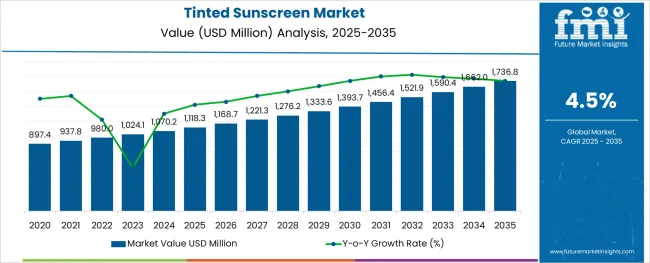
The tinted sunscreen market is growing steadily as consumers increasingly seek skincare products that offer both sun protection and cosmetic benefits. Rising awareness about the harmful effects of UV exposure and skin aging has driven demand for sunscreens that provide effective protection while enhancing skin tone. Advances in formulation technology have enabled the development of tinted products that blend easily and cater to diverse skin types.
The premium category has seen notable growth due to consumers’ willingness to invest in high-quality, multi-functional skincare. Medicated sunscreens, designed to address specific skin concerns, have also contributed to market expansion. The growing female consumer base, which often prioritizes both protection and aesthetics, is fueling demand.
Store-based retail remains an important distribution channel offering wide accessibility and trusted purchase environments. Overall, the market is poised for further growth supported by ongoing product innovation and rising sun safety awareness. Segmental growth is driven by cream product types, SPF levels between 15 and 30, stick forms, premium pricing, medicated categories, female end users, and store-based distribution channels.
The market is segmented by Product Type, SPF, Form, Price Range, Category, End User, and Distribution Channel and region. By Product Type, the market is divided into Cream, Gel, Moisturizer, Lotion, and Powder. In terms of SPF, the market is classified into SPF 15 to 30, SPF 30 to 50, and Above SPF 50+. Based on Form, the market is segmented into Sticks, Tubes, and Roll On. By Price Range, the market is divided into Premium and Economy. By Category, the market is segmented into Medicated and Non-Medicated. By End User, the market is segmented into Female, Male, and Unisex. By Distribution Channel, the market is segmented into Store-Based, Supermarket & Hypermarket, Specialty Stores & Brand Stores, Non-Store-Based, Company Website, and E-Commerce. Regionally, the market is classified into North America, Latin America, Western Europe, Eastern Europe, Balkan & Baltic Countries, Russia & Belarus, Central Asia, East Asia, South Asia & Pacific, and the Middle East & Africa.
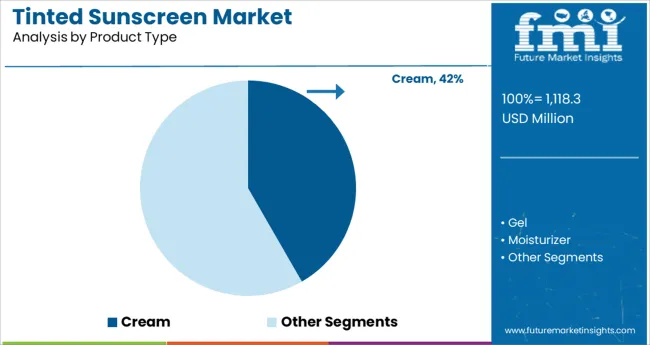
The Cream segment is expected to hold 41.7% of the tinted sunscreen market revenue in 2025, maintaining its leadership position. Cream formulations are favored for their hydrating properties and smooth application, making them suitable for a wide range of skin types. The texture allows for even coverage and effective blending of tint with sun protection ingredients.
Consumers often perceive creams as more moisturizing compared to other forms, which drives preference especially among individuals with dry or sensitive skin. The adaptability of creams to include additional skincare benefits such as anti-aging or medicated ingredients has further supported growth.
The ease of use and familiarity of cream products keeps this segment dominant in consumer choices.
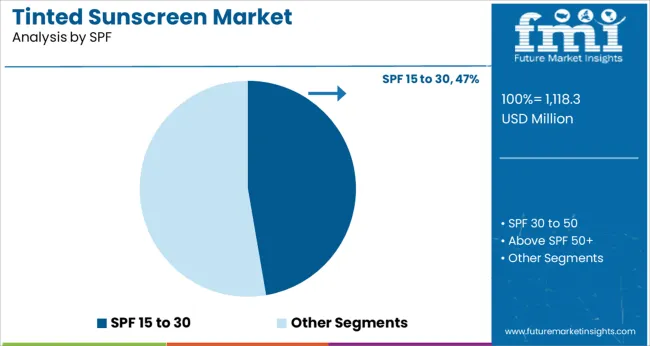
The SPF 15 to 30 segment is projected to account for 47.3% of the market revenue in 2025, making it the leading sun protection factor category. This range offers sufficient daily protection for most skin types and lifestyles, balancing efficacy with cosmetic appeal.
Consumers prefer this SPF range for everyday use as it provides adequate defense against UVB rays without feeling heavy or greasy on the skin. The moderate SPF level supports comfortable wear under makeup or alone and is often recommended by dermatologists for regular exposure.
The combination of protection and cosmetic benefits in this SPF range continues to attract a broad consumer base, sustaining its market leadership.
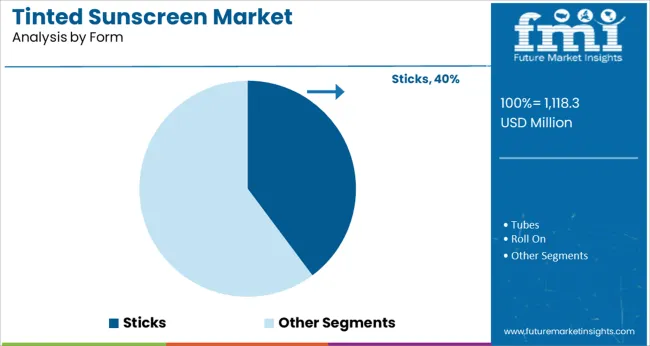
The Stick segment is expected to contribute 39.8% of the tinted sunscreen market revenue in 2025, securing its place as the leading product form. Stick sunscreens offer convenience and portability, making them popular among active consumers and frequent travelers. Their solid format reduces the risk of spills and allows for targeted application on areas such as the face, lips, and ears.
The ease of reapplication during outdoor activities has bolstered demand. Additionally, sticks tend to have longer shelf lives and better stability of active ingredients compared to liquid or cream forms.
Consumer preference for quick, mess-free application has helped the stick format gain prominence in the tinted sunscreen category.
With the growing consumer awareness and healthcare anxieties, sales of tinted sunscreen is gaining popularity as an essential ingredient in a wide range of skin care products. Tinted sunscreen is one such sunscreen products that protect the skin from ultraviolet long-wave (UVA) and ultraviolet shortwave (UVB) rays and also contain SPF for prolonged protection.
Growing penetration and consumption of multifunctional skin care among consumers, rise in demand for tinted sunscreen products, rapidly growing UV radiation level has increased the tinted sunscreen market share. An increase in demand for chemical-free ingredients in the beauty products are the factors influencing the sales of tinted sunscreen in the global market over the forecast years.
Moreover, developing research and development activities in skin care industry such as combining sunscreen with antioxidants such as vitamin C and vitamin E that minimize the sun effect on skin cells is anticipated to increase the sales of tinted sunscreen products. As well as a rise in do-it-yourself natural skin care products are predicted to create the substantial demand for tinted sunscreen in the coming years.
Also, significantly influx of novel sunscreen formulations and wide range of sunscreens in the skin care industry coupled with a rise in demand for sustainable products are some other factors fueling the demand for tinted sunscreen products during the forecast period.
However, banning of certain sunscreen chemicals, side-effects associated with products had a negative impact on the sales of tinted sunscreen products in the recent past. Availability of various types of counterfeit and cheap products in the market are some of the factors that may limit the sales of tinted sunscreen in the global market in the coming days.
Fierce competition among the different cosmetics manufacturing companies has severely fragmented the global demand for tinted sunscreen products limiting the profit margin of market players.
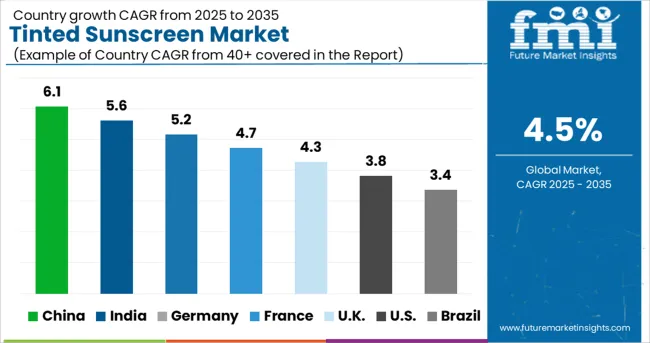
The demand for tinted sunscreen is anticipated to register significant growth across all the regions during the forecast period. The tinted sunscreen market is classified into seven key areas: North America, Europe, Latin America, East Asia, South Asia, Oceania, and the Middle East & Africa.
North America is expected to be the leading region in the global tinted sunscreen market followed by Europe owing to the higher sales of tinted sunscreen products along with high consumer preference for beauty products containing natural ingredients in the region.
South Asia and East Asia tinted sunscreen market share is expected to account a healthy CAGR during the forecast period owing to the rise in consumer awareness pertaining to skincare. MEA is also likely to offer attractive opportunity with the higher demand for tinted sunscreen products in the coming years.

Sone of the key players in the global dry market includes Johnson & Johnson Consumer Inc., Australian Gold LLC, Sweetsation Therapy, Pierre Fabre Dermo-Cosmetique USA, Inc., Coola Suncare LLC, Tizo Company, Tarte Cosmetics, Unilever, First Aid Beauty Ltd., Boscia, LLC, Algenist Brands LLC, Colorescience, Inc., MD SolarSciences Corporation, L'Oréal S.A., MyChelle Dermaceuticals, LLC, SkinMedica Inc., Galderma Laboratories, L.P., Suntegrity Skincare Company, and others
Recent Developments in the Tinted Sunscreen Market
| Report Attribute | Details |
|---|---|
| Growth Rate | CAGR of 4.5% from 2025 to 2035 |
| Base Year of Estimation | 2024 |
| Historical Data | 2014 to 2024 |
| Forecast Period | 2025 to 2035 |
| Quantitative Units | Revenue in billion, Volume in Kilotons and CAGR from 2025 to 2035 |
| Report Coverage | Revenue Forecast, Volume Forecast, Company Ranking, Competitive Landscape, Growth Factors, Trends and Pricing Analysis |
| Segments Covered | Product Type, Form Type, SPF Type, Source, Sales Channel, Region |
| Regions Covered | North America; Latin America; Western Europe; Eastern Europe; APEJ; Japan; Middle East and Africa |
| Key Countries Profiled | USA, Canada, Brazil, Argentina, Germany, UK, France, Spain, Italy, Nordics, BENELUX, Australia & New Zealand, China, India, ASEAN, GCC, South Africa |
| Key Companies Profiled | Johnson & Johnson Consumer Inc.; Australian Gold LLC, Sweetsation Therapy; Pierre Fabre Dermo-Cosmetique USA, Inc.; Coola Suncare LLC; Tizo Company; Tarte Cosmetics, Unilever; First Aid Beauty Ltd.; Boscia, LLC; Algenist Brands LLC; Colorescience, Inc.; MD SolarSciences Corporation; L'Oréal S.A.; MyChelle Dermaceuticals, LLC; SkinMedica Inc.; Galderma Laboratories, L.P.; Suntegrity Skincare Company |
| Customization scope | Available Upon Request |
| Pricing and Purchase Option | Avail Customized purchase options to meet your exact research needs. |
The global tinted sunscreen market is estimated to be valued at USD 1,118.3 million in 2025.
It is projected to reach USD 1,736.8 million by 2035.
The market is expected to grow at a 4.5% CAGR between 2025 and 2035.
The key product types are cream, gel, moisturizer, lotion and powder.
spf 15 to 30 segment is expected to dominate with a 47.3% industry share in 2025.






Our Research Products

The "Full Research Suite" delivers actionable market intel, deep dives on markets or technologies, so clients act faster, cut risk, and unlock growth.

The Leaderboard benchmarks and ranks top vendors, classifying them as Established Leaders, Leading Challengers, or Disruptors & Challengers.

Locates where complements amplify value and substitutes erode it, forecasting net impact by horizon

We deliver granular, decision-grade intel: market sizing, 5-year forecasts, pricing, adoption, usage, revenue, and operational KPIs—plus competitor tracking, regulation, and value chains—across 60 countries broadly.

Spot the shifts before they hit your P&L. We track inflection points, adoption curves, pricing moves, and ecosystem plays to show where demand is heading, why it is changing, and what to do next across high-growth markets and disruptive tech

Real-time reads of user behavior. We track shifting priorities, perceptions of today’s and next-gen services, and provider experience, then pace how fast tech moves from trial to adoption, blending buyer, consumer, and channel inputs with social signals (#WhySwitch, #UX).

Partner with our analyst team to build a custom report designed around your business priorities. From analysing market trends to assessing competitors or crafting bespoke datasets, we tailor insights to your needs.
Supplier Intelligence
Discovery & Profiling
Capacity & Footprint
Performance & Risk
Compliance & Governance
Commercial Readiness
Who Supplies Whom
Scorecards & Shortlists
Playbooks & Docs
Category Intelligence
Definition & Scope
Demand & Use Cases
Cost Drivers
Market Structure
Supply Chain Map
Trade & Policy
Operating Norms
Deliverables
Buyer Intelligence
Account Basics
Spend & Scope
Procurement Model
Vendor Requirements
Terms & Policies
Entry Strategy
Pain Points & Triggers
Outputs
Pricing Analysis
Benchmarks
Trends
Should-Cost
Indexation
Landed Cost
Commercial Terms
Deliverables
Brand Analysis
Positioning & Value Prop
Share & Presence
Customer Evidence
Go-to-Market
Digital & Reputation
Compliance & Trust
KPIs & Gaps
Outputs
Full Research Suite comprises of:
Market outlook & trends analysis
Interviews & case studies
Strategic recommendations
Vendor profiles & capabilities analysis
5-year forecasts
8 regions and 60+ country-level data splits
Market segment data splits
12 months of continuous data updates
DELIVERED AS:
PDF EXCEL ONLINE
Tinted Moisturizer Cream Market Size and Share Forecast Outlook 2025 to 2035
Tinted Cosmetics Market Size and Share Forecast Outlook 2025 to 2035
Tinted Glass Market Growth - Trends & Forecast 2025 to 2035
Peptide-Infused Tinted Moisturizers Market Size and Share Forecast Outlook 2025 to 2035
Mineral Sunscreen Market Size and Share Forecast Outlook 2025 to 2035
Ceramide Sunscreen Market Growth – Size, Trends & Forecast 2024-2034
Zinc Oxide Sunscreens Market Size and Share Forecast Outlook 2025 to 2035
Zinc Oxide for Sunscreens Market Analysis - Size, Share, and Forecast Outlook 2025 to 2035

Thank you!
You will receive an email from our Business Development Manager. Please be sure to check your SPAM/JUNK folder too.
Chat With
MaRIA